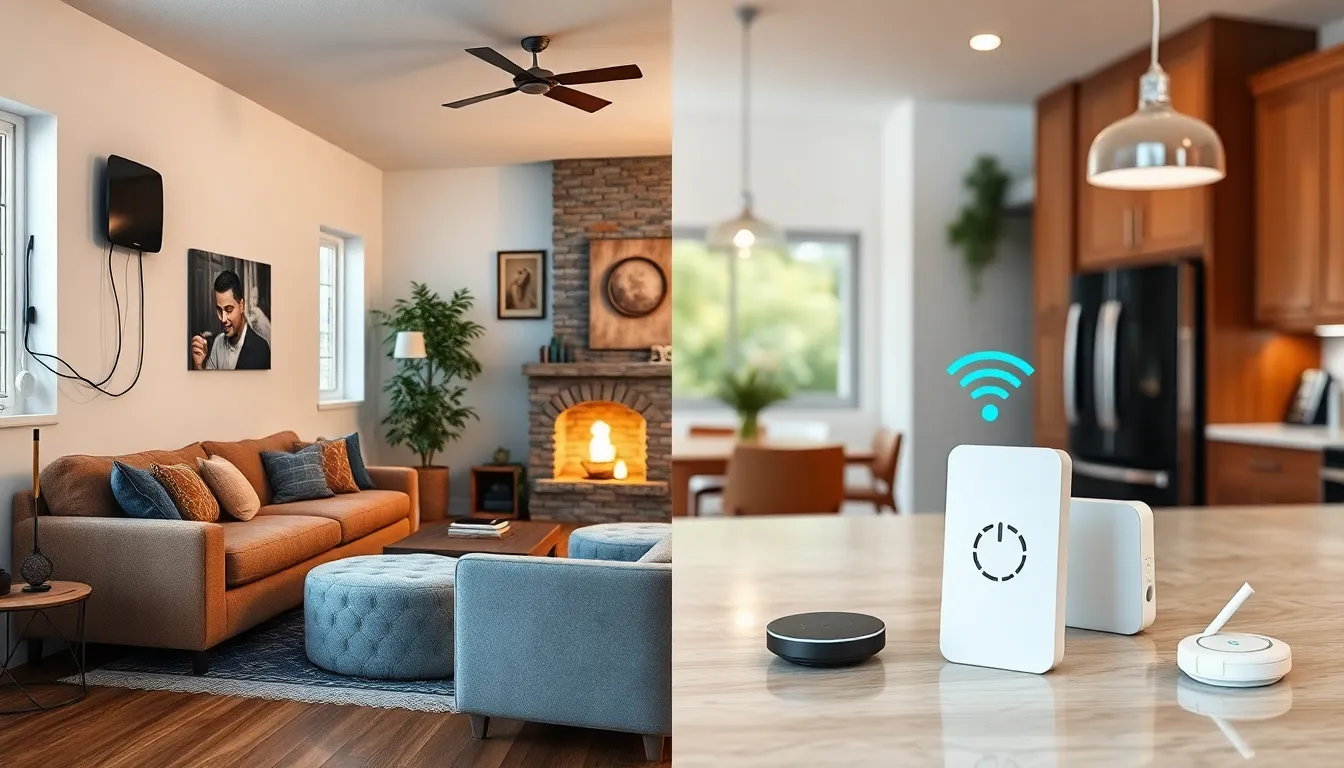In a world where home invasions can happen faster than you can say “Did I leave the oven on?”, a basic home alarm system isn’t just a luxury; it’s a necessity. Imagine your home transforming into a fortress, complete with an invisible moat and a drawbridge (okay, maybe not that dramatic). But with the right alarm system, you’ll sleep like a baby, knowing your castle is secure.
Table of Contents
ToggleOverview of Basic Home Alarm Systems
Basic home alarm systems provide essential protection against unauthorized access. These systems typically include several components that work together to detect intrusions and alert homeowners. Sensors placed on doors and windows detect movement or forced entry.
Control panels serve as the central hub, allowing users to activate or deactivate the system. Many systems utilize keypads for easy access. Additionally, loud sirens trigger when a security breach occurs, drawing attention to the situation.
Monitoring options vary, with some systems offering professional monitoring services. Professional monitoring ensures prompt emergency response, while others rely on local alerts. Wireless technology plays a significant role, enhancing installation ease and providing flexibility.
Homeowners often prioritize features based on their specific needs. Video surveillance cameras provide an added layer of security, enabling remote monitoring and deterring criminal activity. Motion detectors enhance capability, detecting movement in designated areas, even in low-light conditions.
Installation costs depend on the system’s complexity and the included features. Basic systems might start around $200, while advanced models can exceed $1,000. Homeowners should assess their environment and budget when selecting an alarm system.
User training is crucial for maximizing security. Familiarity with component functions and emergency protocols promotes effective response during alarms. Regular maintenance and updates keep systems operating optimally.
Overall, a basic home alarm system enhances security, offering peace of mind in today’s unpredictable environment. Investing in such a system fortifies homes against potential threats, allowing families to feel securely protected.
Types of Basic Home Alarm Systems

Basic home alarm systems fall into two main categories: wired and wireless systems. Each type offers distinct advantages and suits various homeowner needs.
Wired Alarm Systems
Wired alarm systems connect components through physical cables. Installation often requires professional help due to the complexity of running wires throughout a home. Reliability stands as a key benefit since wired systems are less susceptible to signal interference. These systems typically offer more comprehensive coverage and are known for their durability. Costs for installation can vary, usually averaging around $200 to $500, depending on the home’s size and requirements. Additionally, wired systems often provide users with stable performance over time, ensuring security remains constant.
Wireless Alarm Systems
Wireless alarm systems use radio signals to connect components, leading to straightforward installation without the need for extensive wiring. Many homeowners prefer wireless options for their flexibility, allowing easy repositioning of devices like sensors and cameras. Battery-operated components provide additional convenience, minimizing power interruptions. While initial costs might range from $150 to $600, ongoing expenses are usually low, making this an appealing choice for budget-conscious individuals. Wireless systems are particularly advantageous for renters, as they do not require permanent alterations to property structures.
Key Features to Consider
Homeowners should consider several key features when selecting a basic home alarm system. Critical components include motion detectors and door and window sensors, both of which enhance overall security.
Motion Detectors
Motion detectors play an essential role in home security. These devices detect movement within designated areas, triggering alerts when unwanted activity occurs. Most systems use infrared technology to differentiate between human and non-human motion. Some models offer pet-friendly options, reducing false alarms caused by household pets. The installation locations significantly influence their effectiveness; placing them in strategic areas maximizes coverage. Regular maintenance also ensures optimal performance, allowing homeowners to rely on timely alerts.
Door and Window Sensors
Door and window sensors serve as the first line of defense against intrusions. These sensors detect when doors or windows open unexpectedly, triggering the alarm system. Homeowners often opt for magnetic sensors, which are simple yet effective. Wireless options provide flexibility for installation, especially in older homes. Many systems include features like alerts to smartphones, keeping homeowners informed in real-time. Durability and battery life are vital considerations, ensuring long-lasting security coverage throughout the home.
Benefits of Installing a Basic Home Alarm System
Installing a basic home alarm system offers numerous advantages for homeowners. Enhanced security ranks as a primary benefit. An effective system deters potential intruders, reducing the likelihood of break-ins. Peace of mind follows closely; knowing that a reliable alarm is active allows families to feel safe, even when they’re away from home.
Affordability can be a significant factor. A basic system typically ranges from $200 to $1,000, making it accessible for various budgets. Cost-effective options exist that provide essential features without overspending. Flexibility in installation also enhances appeal; wireless systems cater well to both renters and homeowners, enabling easy setup without the need for extensive renovations.
Monitoring capabilities contribute significantly to overall safety. Many basic alarm systems come with options for professional monitoring services, ensuring prompt responses to emergencies. Local alerts also serve effectively by notifying homeowners of breaches. Quick alerts help mitigate potential damage, offering a swift course of action.
Advanced features often accompany basic systems as well. Cameras can be integrated for video surveillance, enabling real-time monitoring of the property. Motion detectors add another layer of security, enhancing the system’s effectiveness against intrusions. Prioritizing systems with these additional features can yield considerable benefits.
User-friendly controls and consistency in maintenance further improve effectiveness. Simple interfaces make it easy for anyone to operate the system. Regular checks ensure all components function properly, maximizing protection over time. Emphasizing these practices helps maintain a secure environment.
The range of benefits associated with basic home alarm systems supports their installation. From deterring intruders to providing peace of mind, these systems prove invaluable in today’s world.
Common Concerns and Limitations
Basic home alarm systems present certain concerns along with limitations that homeowners should consider. False alarms frequently occur, causing frustration for users and potentially leading to fines from local authorities. Regular maintenance and proper user training help mitigate this issue.
Cost factors also play a significant role in the decision-making process. Installation expenses for wired systems can range between $200 and $500, while wireless options generally fall between $150 and $600. Budget constraints may affect choices among various system features.
Reliability and signal interference are additional considerations for wireless systems. Obstacles such as walls and electronic devices might disrupt signals, impacting performance. Strategic placement of sensors often reduces potential interferences.
Monitoring variations exist as well. While professional monitoring services provide prompt responses to emergencies, homeowners sometimes prefer local alerts for notifications. Individual preferences should guide the choice between professional and self-monitoring.
System compatibility and scalability become pertinent when considering future upgrades. Not all components of basic systems are interchangeable, and future expansions may require purchasing specific devices from the same manufacturer. This limitation affects users who might want to enhance their systems later.
Environmental factors also play a role in system effectiveness. Outdoor sensors face challenges from extreme weather conditions or wildlife, potentially leading to frequent notifications. Monitoring and adjusting settings according to environmental needs ensure optimum performance.
Finally, user experience remains critical. Complex controls or confusing interfaces can deter effective use, which diminishes system reliability. Prioritizing user-friendly options helps maximize engagement and security effectiveness.
Investing in a basic home alarm system is a proactive step toward securing one’s living space. With various options available homeowners can choose systems that best fit their needs and budget. The right combination of sensors and monitoring can significantly enhance safety and deter potential threats.
Regular maintenance and user training will ensure that these systems operate effectively. By evaluating the features and understanding the limitations of both wired and wireless systems, homeowners can create a personalized security solution. Ultimately, a reliable alarm system not only protects property but also fosters peace of mind for families, allowing them to enjoy their homes without worry.


